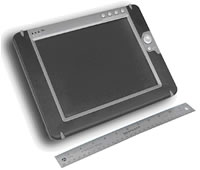 Siemens have announced the availability of a range of handsets that work with VoIP (Voice over IP) software, Skype. Simply by plugging the USB adapter into a computer running an updated version of Skype, home and business users will be able to make calls using a cordless handset. Calls to other Skype users will be free and calls to International landlines can be made at very low cost using SkypeOut.
Siemens have announced the availability of a range of handsets that work with VoIP (Voice over IP) software, Skype. Simply by plugging the USB adapter into a computer running an updated version of Skype, home and business users will be able to make calls using a cordless handset. Calls to other Skype users will be free and calls to International landlines can be made at very low cost using SkypeOut.
For those of you who like model numbers – the Siemens Gigaset M34 USB PC adapter works with the recently launched Gigaset C340/345 and Gigaset CX340/345isdn, Gigaset S440/445 and Gigaset SX440/445isdn, Gigaset S645 and Gigaset SL440.
The handset range is, in itself, pretty impressive featuring some with built-in cameras capable of sending MMS and others able to do Instant Messanging (IM). Remember, these are not cellular phones, but are for home or office use.
When we spoke to Siemens they told us that you can walk into a shop in Germany and buy many of these handsets today. There are ongoing discussions with UK retailers and it’s likely that the M34 USB adaptor will be bundled with handsets – guide price £100 for the Gigaset C340/M34 bundle, with availability probably post-xmas.
The real strength of this deal is that normal, average home users will be able to use VoIP, using a hand-set that is familiar to them. They won’t have to go to their computer to make a Skype call and dig deep into software.
The deal was first announced in March at CeBIT 2004 and was originally slated for release in September. Reasons for the delay are currently unclear.
We imagine that Skype must be pretty pleased with this deal. Not only do they enable people to use their service on a phone but it gives Skype a mainstream legitimacy that was previously lacking.
What is slightly unexpected about this is that Siemens, a provider of POTS (Plain Old Telephone System), is voluntarily moving to VoIP. It is another clear sign of the acceptance from ‘old school’ telephony companies that VoIP is the way forward. Marketing-wise it’s a great way for them to shake off this old image and appear ‘down with the new tech kids’.
We’ve been experimenting at the Digital Lifestyles studio with using a Bluetooth Jabra BT250v headset and a Belkin Bluetooth Adaptor to make Skype calls. On the whole it works, but the setup is definitely not consumer friendly as yet.
 The latest addition to Sony’s VAIO range of personal computers is really, really different. The VAIO VGN-U750P (around US$2,000) is a palmtop computer that also goes under the more firendly name of the Vaio U and weighs considerably less than the average laptop (167x108x26mm, 550g), yet boasts a fully fledged Intel-based environment running Windows XP Professional SP2 as opposed to the specialised platforms powering other handhelds, such as Palm OS, Windows Mobile or even Windows XP Tablet PC Edition.
The latest addition to Sony’s VAIO range of personal computers is really, really different. The VAIO VGN-U750P (around US$2,000) is a palmtop computer that also goes under the more firendly name of the Vaio U and weighs considerably less than the average laptop (167x108x26mm, 550g), yet boasts a fully fledged Intel-based environment running Windows XP Professional SP2 as opposed to the specialised platforms powering other handhelds, such as Palm OS, Windows Mobile or even Windows XP Tablet PC Edition. Designed for law enforcement, perimeter security and long-range video links,
Designed for law enforcement, perimeter security and long-range video links,  Linksys’ consumer and small-business oriented
Linksys’ consumer and small-business oriented